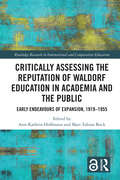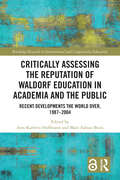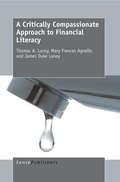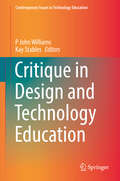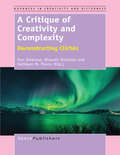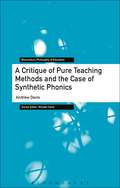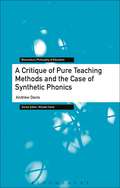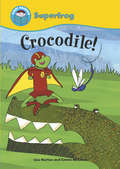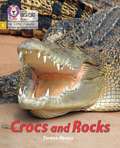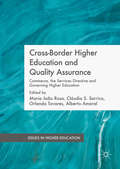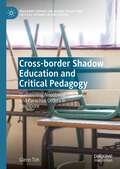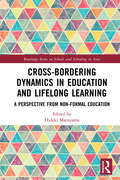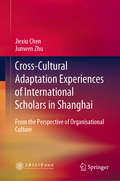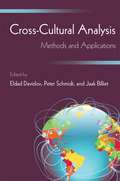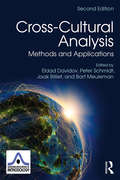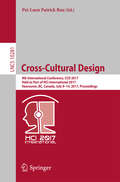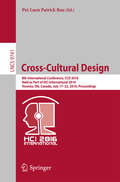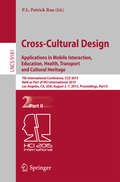- Table View
- List View
Critically Assessing the Reputation of Waldorf Education in Academia and the Public: Early Endeavours of Expansion, 1919–1955 (Routledge Research in International and Comparative Education)
by Ann-Kathrin Hoffmann Marc Fabian BuckThe first of two volumes dedicated to this little-explored topic, this volume gathers international perspectives to critically assess how Waldorf education has been perceived and discussed in both public and academic arenas. The book thereby challenges the historical concept of Waldorf education as an international movement championing “progressive education.”Spanning the period 1919–1955, this first volume looks at countries with a longstanding tradition of Waldorf schools: Germany, The Netherlands, Norway, Switzerland, Austria, and Finland. The second volume, which covers the period 1987–2004, focuses on more recent developments in Japan, Israel, Spain, Poland, Kenya, France, Slovenia, and China. Throughout both books, over 25 leading scholars present 16 case studies spanning 14 countries to discuss the history and perception of Waldorf education in the context of respective school systems and societies. By exploring the ramifications of these case studies against the background of existing research, the books offer cutting-edge perspectives and prompts for scholarly debates for this as-yet under-researched field.This book will be of interest to researchers, scholars, and postgraduate students in international and comparative education, the theory of education, and the philosophy of education. Policy makers interested in the history of education, as well as practicing teachers and school staff at Waldorf education institutions, may also benefit from the volume.
Critically Assessing the Reputation of Waldorf Education in Academia and the Public: Early Endeavours of Expansion, 1919–1955 (Routledge Research in International and Comparative Education)
The first of two volumes dedicated to this little-explored topic, this volume gathers international perspectives to critically assess how Waldorf education has been perceived and discussed in both public and academic arenas. The book thereby challenges the historical concept of Waldorf education as an international movement championing “progressive education.”Spanning the period 1919–1955, this first volume looks at countries with a longstanding tradition of Waldorf schools: Germany, The Netherlands, Norway, Switzerland, Austria, and Finland. The second volume, which covers the period 1987–2004, focuses on more recent developments in Japan, Israel, Spain, Poland, Kenya, France, Slovenia, and China. Throughout both books, over 25 leading scholars present 16 case studies spanning 14 countries to discuss the history and perception of Waldorf education in the context of respective school systems and societies. By exploring the ramifications of these case studies against the background of existing research, the books offer cutting-edge perspectives and prompts for scholarly debates for this as-yet under-researched field.This book will be of interest to researchers, scholars, and postgraduate students in international and comparative education, the theory of education, and the philosophy of education. Policy makers interested in the history of education, as well as practicing teachers and school staff at Waldorf education institutions, may also benefit from the volume.
Critically Assessing the Reputation of Waldorf Education in Academia and the Public: Recent Developments the World Over, 1987–2004 (Routledge Research in International and Comparative Education)
by Ann-Kathrin Hoffmann Marc Fabian BuckThe second of two volumes dedicated to this little-explored topic continues to gather international perspectives to critically assess how Waldorf education has been perceived and discussed in both public and academic arenas. Both books thereby challenge the historic concept of Waldorf education as an international movement championing “progressive education.”Spanning the period 1987–2004, this second volume focuses on more recent developments in Waldorf education in Japan, Israel, Spain, Poland, Kenya, France, Slovenia, and China. Throughout both books, over 25 leading scholars present 16 case studies spanning 14 countries to discuss the history and perception of Waldorf education in the context of respective school systems and societies. By exploring the ramifi cations of these case studies against the background of existing research, the books offer cutting-edge perspectives and prompts for scholarly debates for this as yet underresearched field.This book will be of interest to researchers, scholars, and postgraduate students in international and comparative education, the theory of education, and the philosophy of education. Policy makers interested in the history of education as well as practicing teachers and school staff at Waldorf education institutions may also benefi t from the volume.
Critically Assessing the Reputation of Waldorf Education in Academia and the Public: Recent Developments the World Over, 1987–2004 (Routledge Research in International and Comparative Education)
The second of two volumes dedicated to this little-explored topic continues to gather international perspectives to critically assess how Waldorf education has been perceived and discussed in both public and academic arenas. Both books thereby challenge the historic concept of Waldorf education as an international movement championing “progressive education.”Spanning the period 1987–2004, this second volume focuses on more recent developments in Waldorf education in Japan, Israel, Spain, Poland, Kenya, France, Slovenia, and China. Throughout both books, over 25 leading scholars present 16 case studies spanning 14 countries to discuss the history and perception of Waldorf education in the context of respective school systems and societies. By exploring the ramifi cations of these case studies against the background of existing research, the books offer cutting-edge perspectives and prompts for scholarly debates for this as yet underresearched field.This book will be of interest to researchers, scholars, and postgraduate students in international and comparative education, the theory of education, and the philosophy of education. Policy makers interested in the history of education as well as practicing teachers and school staff at Waldorf education institutions may also benefi t from the volume.
A Critically Compassionate Approach to Financial Literacy
by Thomas A. Lucey Mary Frances Agnello James Duke LaneyA Critically Compassionate Approachto Financial Literacy offers a unique approach to conceptualizing financial literacy. Differentiating between notions of financial worth and personal self-worth, the authors present a description of financial literacy tenets founded in principles of self-awareness and cooperative community that are rooted in principles of compassion. Basing their work on principles of psychological and archeological research that associates personal wellness with self-security based on principles of trust, the authors posit that personal fulfillment occurs independently of accumulated financial resources. Featuring standards for Grades 4 and 8, offering stimulating questions for discussion, and ideas for classroom activities, ACritically Compassionate Approach to Financial Literacy represents an engaging classroom resource for elementary and middle level social studies methods courses as well as those that concern topics that relate to culturally responsive teaching and social justice. Regardless of your financial background and awareness, this text will challenge your thinking about the meaning of being financially literate and the consequences for society.
Critique in Design and Technology Education (Contemporary Issues in Technology Education)
by P John Williams Kay StablesThis book addresses notions of critique in Design and Technology Education, facilitating a conceptual and practical understanding of critique, and enabling both a personal and pedagogical application to practice.Critique can be a frame of mind, and may be related to a technology, product, process or material. In a holistic sense, critique is an element of a person’s technological literacy, a fundamentally critical disposition brought to bear on all things technological. This book provides a reasoned conceptual framework within which to develop critique, and examples of applying the framework to Design and Technology Education. The book builds on The Future of Technology Education published by Springer as the first in the series Contemporary Issues in Technology Education.In the 21st century, an ‘age of knowledge’, students are called upon to access, analyse and evaluate constantly changing information to support personal and workplace decision making and on-going innovation. A critical Design and Technology Education has an important role to play, providing students with opportunities to integrate economic, environmental, social and technological worlds as they develop and refine their technological literacy. Through the design and development of technology, they collaborate, evaluate and critically apply information, developing cognitive and manipulative skills appropriate to the 21st century. Critique goes beyond review or analysis, addressing positive and negative technological development. This book discusses and applies this deeper perspective, identifying a clear role for critique in the context of Design and Technology Education.
A Critique of Creativity and Complexity: Deconstructing Clichés (Advances in Creativity and Giftedness #25)
by Don Ambrose Bharath Sriraman Kathleen M. PierceIn an increasingly complex world the natural human inclination is to oversimplify issues and problems to make them seem more comprehensible and less threatening. This tendency usually generates forms of dogmatism that diminish our ability to think creatively and to develop worthy talents. Fortunately, complexity theory is giving us ways to make sense of intricate, evolving phenomena. This book represents a broad, interdisciplinary application of complexity theory to a wide variety of phenomena in general education, STEM education, learner diversity and special education, social-emotional development, organizational leadership, urban planning, and the history of philosophy. The contributors provide nuanced analyses of the structures and dynamics of complex adaptive systems in these academic and professional fields.
A Critique of Pure Teaching Methods and the Case of Synthetic Phonics (Bloomsbury Philosophy of Education)
by Andrew DavisA Critique of Pure Teaching Methods and the Case of Synthetic Phonics examines how research into the effectiveness of teaching methods can and should relate to what takes place in the classroom. The discussion brings to light some important features of the way we classify teaching activities. The classifications are unlike those we use in natural science – for instance, how we classify drug dosages. This point has very important implications for what should be considered the appropriate relationships between educational research and classroom practice.Andrew Davis applies the results of this discussion to the teaching of early reading, focussing in particular on the approach known as synthetic phonics. He provides a philosophical investigation into the nature of reading, and into the concepts that feature in approaches to teaching it, such as the idea of building words from letter sounds, the nature of words themselves and reading for meaning. He concludes with a discussion of why this matters so much, reflecting on how stories and books can be part of a child's emerging identity within the family. He explores how values of family life should be weighed against the importance of achievements in school, and argues for the claim that school reading policies of certain kinds may have a destructive impact if they are felt to trump the private interests of children and their families.
A Critique of Pure Teaching Methods and the Case of Synthetic Phonics (Bloomsbury Philosophy of Education)
by Andrew DavisA Critique of Pure Teaching Methods and the Case of Synthetic Phonics examines how research into the effectiveness of teaching methods can and should relate to what takes place in the classroom. The discussion brings to light some important features of the way we classify teaching activities. The classifications are unlike those we use in natural science – for instance, how we classify drug dosages. This point has very important implications for what should be considered the appropriate relationships between educational research and classroom practice.Andrew Davis applies the results of this discussion to the teaching of early reading, focussing in particular on the approach known as synthetic phonics. He provides a philosophical investigation into the nature of reading, and into the concepts that feature in approaches to teaching it, such as the idea of building words from letter sounds, the nature of words themselves and reading for meaning. He concludes with a discussion of why this matters so much, reflecting on how stories and books can be part of a child's emerging identity within the family. He explores how values of family life should be weighed against the importance of achievements in school, and argues for the claim that school reading policies of certain kinds may have a destructive impact if they are felt to trump the private interests of children and their families.
Crocodile!: Superfrog: Crocodile! (Start Reading: Superfrog)
by Liss NortonWhen Fergus and his best friend, Doris, hear a strange noise, they fly off to investigate. What they don't expect to find is an angry, hungry crocodile!
Crocodiles Can't Climb Trees: Targeting the k Sound (Speech Bubbles 1)
by Melissa PalmerLucas the Monkey loves to play soccer by the river, but he has a problem – Mr. Crocodile, who would love to make Lucas his dinner. This picture book targets the /k/ sound, and is part of Speech Bubbles 1, a series of picture books that target specific speech sounds within the story. The series can be used for children receiving speech therapy, for children who have a speech sound delay/disorder, or simply as an activity for children’s speech sound development and/or phonological awareness. They are ideal for use by parents, teachers or caregivers. Bright pictures and a fun story create an engaging activity perfect for sound awareness. Please see other titles in the series for stories targeting other speech sounds.
Crocodiles Can't Climb Trees: Targeting the k Sound (Speech Bubbles 1)
by Melissa PalmerLucas the Monkey loves to play soccer by the river, but he has a problem – Mr. Crocodile, who would love to make Lucas his dinner. This picture book targets the /k/ sound, and is part of Speech Bubbles 1, a series of picture books that target specific speech sounds within the story. The series can be used for children receiving speech therapy, for children who have a speech sound delay/disorder, or simply as an activity for children’s speech sound development and/or phonological awareness. They are ideal for use by parents, teachers or caregivers. Bright pictures and a fun story create an engaging activity perfect for sound awareness. Please see other titles in the series for stories targeting other speech sounds.
Crocs And Rocks: Phase 5 (Big Cat Phonics For Little Wandle Letters And Sounds Revised Ser.)
by Teresa Heapy Collins Big CatCollins Big Cat Phonics for Letters and Sounds features exciting fiction and non-fiction decodable readers to enthuse and inspire children. They are fully aligned to Letters and Sounds Phases 1-6 and contain notes in the back. The Handbooks provide support in demonstration and modelling, monitoring comprehension and expanding vocabulary. This photographic non-fiction book invites you in to experience the activities, animals, art and natural beauty of Kakadu National Park in Australia. Orange/Band 6 offers varied text and characters, with action sustained over several pages. The focus sounds in this book are: /ee/ e, y, e-e /j/ g, ge /f/ ph /l/ le /z/ se /igh/ y /w/ wh /ai/ a /ch/ tch /v/ ve /s/ se Pages 22 and 23 allow children to re-visit the content of the book, supporting comprehension skills, vocabulary development and recall. Reading notes within the book provide practical support for reading Big Cat Phonics for Letters and Sounds with children, including a list of all the sounds and words that the book will cover.
Cross-Border Higher Education and Quality Assurance: Commerce, the Services Directive and Governing Higher Education (Issues in Higher Education)
by Alberto Amaral Maria João Rosa Cláudia S. Sarrico Orlanda TavaresThis book analyses the range of potential measures national quality assurance agencies may have to employ to deal with the new issues caused by Cross Border Higher Education (CBHE). The expansion of CBHE raises quality problems, which are currently assessed differently depending on the countries concerned. This has been exacerbated by the growth of Massive Open Online Courses (MOOCs) which have developed very quickly and can be prone to rogue providers. This book considers the steps that have already been taken to ensure quality as well as those ahead. It is important that the swift growth of CBHE is not just seen as a means to increase the revenues of higher education institutions faced with decreasing public funding but also as a means to keep educational standards high.
Cross-border Shadow Education and Critical Pedagogy: Questioning Neoliberal And Parochial Orders In Singapore (Palgrave Studies On Global Policy And Critical Futures In Education Ser.)
by Glenn TohThis book explores critical pedagogy and issues relating to entrepreneurialism, commodification, and marketization in education, and their deleterious effects on student agency and subjectivity. The central theme of the book is a cross-border critical ethnographic study of the shadow education practices of an overseas Japanese business community in Singapore which draws attention to the elaborate extent to which families are engaged in shadow or cram tutoring practices as part of their children’s education, supported by the strong presence of overseas branches of well-established corporate tutoring businesses headquartered in Japan. The author ultimately critiques a banking approach to education, particularly in terms of its oppressive and dehumanizing outcomes, sustained by the inner workings of neoliberal forces and mercantilist ideologies.
Cross-Bordering Dynamics in Education and Lifelong Learning: A Perspective from Non-Formal Education (Routledge Series on Schools and Schooling in Asia)
by Hideki MaruyamaEducation as a concept has long been taken for granted. Most people immediately think of schools and colleges, of classes and exams. This volume aims to highlight non-formal education (NFE) in its various forms across different historical and cultural contexts. Contributors draw upon their experience as educators and researchers in comparative education and sociology to elucidate, compare, and critique NFE in Asia, Europe, Latin America, and the USA. By mapping out NFE’s forms, functions, and dynamics, this volume gives us the opportunity to reflect on the myriad iterations of education to challenge preconceived limitations in the field of education research. Only by expanding the focus beyond that of traditional schooling arrangements can we work towards a more sustainable future and improved lifelong learning. This book will appeal to researchers interested in non-formal education and comparative education.
Cross-Bordering Dynamics in Education and Lifelong Learning: A Perspective from Non-Formal Education (Routledge Series on Schools and Schooling in Asia)
by Hideki MaruyamaEducation as a concept has long been taken for granted. Most people immediately think of schools and colleges, of classes and exams. This volume aims to highlight non-formal education (NFE) in its various forms across different historical and cultural contexts. Contributors draw upon their experience as educators and researchers in comparative education and sociology to elucidate, compare, and critique NFE in Asia, Europe, Latin America, and the USA. By mapping out NFE’s forms, functions, and dynamics, this volume gives us the opportunity to reflect on the myriad iterations of education to challenge preconceived limitations in the field of education research. Only by expanding the focus beyond that of traditional schooling arrangements can we work towards a more sustainable future and improved lifelong learning. This book will appeal to researchers interested in non-formal education and comparative education.
Cross-Cultural Adaptation Experiences of International Scholars in Shanghai: From the Perspective of Organisational Culture
by Jiexiu Chen Junwen ZhuThis book examines the cross-cultural adaptation experiences of international scholars working at Shanghai’s top public research universities. On the basis of in-depth interviews, it comprehensively assesses the organisational culture of Chinese universities, recurring problems in international scholars’ cross-cultural adaptation processes, and the coping strategies they employ in response.The book focus on the real lives and working experiences of international scholars in China, and addresses teaching, research, funding applications and organisational politics. Accordingly, it offers a wealth of first-hand information for readers who are interested in the Chinese academic world, especially those scholars/researchers/expatriates currently working in or planning to visit/work in China.
Cross-Cultural Analysis: Methods and Applications
by Eldad Davidov Peter Schmidt Jaak Billiet Bart MeulemanIntended to bridge the gap between the latest methodological developments and cross-cultural research, this interdisciplinary resource presents the latest strategies for analyzing cross-cultural data. Techniques are demonstrated through the use of applications that employ cross national data sets such as the latest European Social Survey. With an emphasis on the generalized latent variable approach, internationally–prominent researchers from a variety of fields explain how the methods work, how to apply them, and how they relate to other methods presented in the book. Syntax and graphical and verbal explanations of the techniques are included. A website features some of the data sets and syntax commands used in the book. Applications from the behavioral and social sciences that use real data-sets demonstrate: The use of samples from 17 countries to validate the resistance to change scale across these nations How to test the cross-national invariance properties of social trust The interplay between social structure, religiosity, values, and social attitudes A comparison of anti-immigrant attitudes and patterns of religious orientations across European countries. The book is divided into techniques for analyzing cross-cultural data within the generalized-latent-variable approach: multiple-group confirmatory factor analysis and multiple-group structural equation modeling; multi-level analysis; latent class analysis; and item-response theory. Since researchers from various disciplines often use different methodological approaches, a consistent framework for describing and applying each method is used so as to cross ‘methodological borders’ between disciplines. Some chapters describe the basic strategy and how it relates to other techniques presented in the book, others apply the techniques and address specific research questions, and a few combine the two. A table in the preface highlights for each chapter: a description of the contents, the statistical methods used, the goal(s) of the analysis, and the data set employed. This book is intended for researchers, practitioners, and advanced students interested in cross-cultural research. Because the applications span a variety of disciplines, the book will appeal to researchers and students in: psychology, political science, sociology, education, marketing and economics, geography, criminology, psychometrics, epidemiology, and public health, as well as those interested in methodology. It is also appropriate for an advanced methods course in cross-cultural analysis.
Cross-Cultural Analysis: Methods and Applications
by Eldad Davidov Peter Schmidt Jaak Billiet Bart MeulemanIntended to bridge the gap between the latest methodological developments and cross-cultural research, this interdisciplinary resource presents the latest strategies for analyzing cross-cultural data. Techniques are demonstrated through the use of applications that employ cross national data sets such as the latest European Social Survey. With an emphasis on the generalized latent variable approach, internationally–prominent researchers from a variety of fields explain how the methods work, how to apply them, and how they relate to other methods presented in the book. Syntax and graphical and verbal explanations of the techniques are included. A website features some of the data sets and syntax commands used in the book. Applications from the behavioral and social sciences that use real data-sets demonstrate: The use of samples from 17 countries to validate the resistance to change scale across these nations How to test the cross-national invariance properties of social trust The interplay between social structure, religiosity, values, and social attitudes A comparison of anti-immigrant attitudes and patterns of religious orientations across European countries. The book is divided into techniques for analyzing cross-cultural data within the generalized-latent-variable approach: multiple-group confirmatory factor analysis and multiple-group structural equation modeling; multi-level analysis; latent class analysis; and item-response theory. Since researchers from various disciplines often use different methodological approaches, a consistent framework for describing and applying each method is used so as to cross ‘methodological borders’ between disciplines. Some chapters describe the basic strategy and how it relates to other techniques presented in the book, others apply the techniques and address specific research questions, and a few combine the two. A table in the preface highlights for each chapter: a description of the contents, the statistical methods used, the goal(s) of the analysis, and the data set employed. This book is intended for researchers, practitioners, and advanced students interested in cross-cultural research. Because the applications span a variety of disciplines, the book will appeal to researchers and students in: psychology, political science, sociology, education, marketing and economics, geography, criminology, psychometrics, epidemiology, and public health, as well as those interested in methodology. It is also appropriate for an advanced methods course in cross-cultural analysis.
Cross-Cultural Analysis: Methods and Applications, Second Edition (European Association of Methodology Series)
by Eldad Davidov Peter Schmidt Jaak Billiet Bart MeulemanIntended to bridge the gap between the latest methodological developments and cross-cultural research, this interdisciplinary resource presents the latest strategies for analyzing cross-cultural data. Techniques are demonstrated through the use of applications that employ cross-national data sets such as the latest European Social Survey. With an emphasis on the generalized latent variable approach, internationally prominent researchers from a variety of fields explain how the methods work, how to apply them, and how they relate to other methods presented in the book. Syntax and graphical and verbal explanations of the techniques are included. Online resources, available at www.routledge.com/9781138690271, include some of the data sets and syntax commands used in the book. Applications from the behavioral and social sciences that use real data-sets demonstrate: The use of samples from 17 countries to validate the resistance to change scale across these nations How to test the cross-national invariance properties of social trust The interplay between social structure, religiosity, values, and social attitudes A comparison of anti-immigrant attitudes and patterns of religious orientations across European countries. The second edition includes six new chapters and two revised ones presenting exciting developments in the literature of cross-cultural analysis including topics such as approximate measurement invariance, alignment optimization, sensitivity analyses, a mixed-methods approach to test for measurement invariance, and a multilevel structural equation modeling approach to explain noninvariance. This book is intended for researchers, practitioners, and advanced students interested in cross-cultural research. Because the applications span a variety of disciplines, the book will appeal to researchers and students in: psychology, political science, sociology, education, marketing and economics, geography, criminology, psychometrics, epidemiology, and public health, as well as those interested in methodology. It is also appropriate for an advanced methods course in cross-cultural analysis.
Cross-Cultural Analysis: Methods and Applications, Second Edition (European Association of Methodology Series)
by Eldad Davidov Peter Schmidt Jaak Billiet Bart MeulemanIntended to bridge the gap between the latest methodological developments and cross-cultural research, this interdisciplinary resource presents the latest strategies for analyzing cross-cultural data. Techniques are demonstrated through the use of applications that employ cross-national data sets such as the latest European Social Survey. With an emphasis on the generalized latent variable approach, internationally prominent researchers from a variety of fields explain how the methods work, how to apply them, and how they relate to other methods presented in the book. Syntax and graphical and verbal explanations of the techniques are included. Online resources, available at www.routledge.com/9781138690271, include some of the data sets and syntax commands used in the book. Applications from the behavioral and social sciences that use real data-sets demonstrate: The use of samples from 17 countries to validate the resistance to change scale across these nations How to test the cross-national invariance properties of social trust The interplay between social structure, religiosity, values, and social attitudes A comparison of anti-immigrant attitudes and patterns of religious orientations across European countries. The second edition includes six new chapters and two revised ones presenting exciting developments in the literature of cross-cultural analysis including topics such as approximate measurement invariance, alignment optimization, sensitivity analyses, a mixed-methods approach to test for measurement invariance, and a multilevel structural equation modeling approach to explain noninvariance. This book is intended for researchers, practitioners, and advanced students interested in cross-cultural research. Because the applications span a variety of disciplines, the book will appeal to researchers and students in: psychology, political science, sociology, education, marketing and economics, geography, criminology, psychometrics, epidemiology, and public health, as well as those interested in methodology. It is also appropriate for an advanced methods course in cross-cultural analysis.
Cross-Cultural Design: 9th International Conference, CCD 2017, Held as Part of HCI International 2017, Vancouver, BC, Canada, July 9-14, 2017, Proceedings (Lecture Notes in Computer Science #10281)
by Pei-Luen Patrick RauThis book constitutes the proceedings of the 9th International Conference on Cross-Cultural Design, CCD 2017, held as part of the 19th International Conference on Human-Computer Interaction, HCII 2017, held in Vancouver, Canada, in July 2017. HCII 2017 received a total of 4340 submissions, of which 1228 papers were accepted for publication after a careful reviewing process. The papers thoroughly cover the entire field of Human-Computer Interaction, addressing major advances in knowledge and effective use of computers in a variety of application areas. The 60 papers presented in the CCD 2017 proceedings are organized in topical sections: cultural foundations of design; cross-cultural product and service design; cross-cultural communication; design for social development; cross-cultural design for learning.
Cross-Cultural Design: 8th International Conference, CCD 2016, Held as Part of HCI International 2016, Toronto, ON, Canada, July 17-22, 2016, Proceedings (Lecture Notes in Computer Science #9741)
by Pei-Luen Patrick RauThis book constitutes the proceedings of the 8th International Conference on Cross-Cultural Design, CCD 2016, held as part of the 18th International Conference on Human-Computer Interaction, HCII 2016, held in Toronto, ON, Canada, in July 2016 and received a total of 4354 submissions, of which 1287 papers and 186 poster papers were accepted for publication after a careful reviewing process. These papers address the latest research and development efforts and highlight the human aspects of design and use of computing systems. The papers thoroughly cover the entire field of Human-Computer Interaction, addressing major advances in knowledge and effective use of computers in a variety of application areas. The 81 papers presented in the CCD 2016 proceedings are organized in topical sections as follows: culture and user experience; cross-cultural product and service design; cultural ergonomics; culture and mobile interaction; culture in smart environments; cross-cultural design for health, well-being and inclusion; and culture for e-commerce and business.
Cross-Cultural Design: 7th International Conference, CCD 2015, Held as Part of HCI International 2015, Los Angeles, CA, USA, August 2-7, 2015, Proceedings, Part II (Lecture Notes in Computer Science #9181)
by P.L. Patrick RauThe two LNCS volume set 9180-9181 constitutes the refereed proceedings of the 7th International Conference on Cross-Cultural Design, CCD 2015, held as part of the 17th International Conference on Human-Computer Interaction, HCII 2015, in Los Angeles, CA, USA in August 2015, jointly with 15 other thematically similar conferences. The total of 1462 papers and 246 posters presented at the HCII 2015 conferences were carefully reviewed and selected from 4843 submissions. These papers of the two volume set address as follows: LNCS 9180, Cross-Cultural Design: Methods, Practice and Impact (Part I), addressing the following major topics: cross-cultural product design, cross-cultural design methods and case studies, design, innovation, social development and sustainability and LNCS 9181, Cross-Cultural Design: Applications in Mobile Interaction, Education, Health, Transport and Cultural Heritage (Part II), addressing the following major topics: cultural aspects of social media and mobile services, culture for transport and travel, culture for design and design for culture and culture for health, learning and games.
